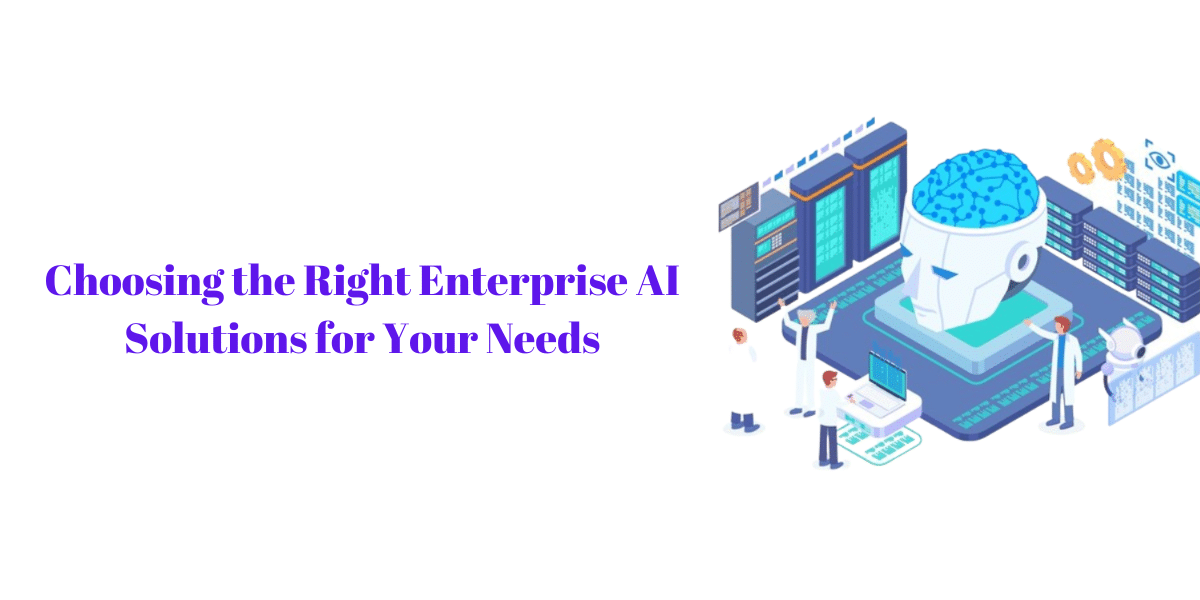Finding the most effective AI solutions has become a top priority for many companies in recent years, and it has the potential to transform the way businesses operate and make their decisions. By analyzing and collecting crucial customer information, AI can provide insights into customer’s behavior and preferences that allow companies to improve their marketing efforts and e-commerce platforms.
AI can also help companies simplify their hiring processes, reduce customer care costs, and boost cash flow forecasting. However, many companies are slow to embrace AI partially because of the difficulties of navigating a competitive and often overwhelming market of AI companies.
The choice of the right artificial intelligence platform is vital for your company. However, there are many things to consider before making the final decision. This complete buyer’s guide was intended to help potential buyers navigate the maze of choosing the most suitable Enterprise AI platform created by Top AI Enterprise Companies by covering crucial aspects and providing informative information.
We’ll guide you through the steps to analyze your company’s requirements and the various models and their functions, pick the best option for sourcing, and consider how to increase the solution’s effectiveness. These steps will assist you in finding the best AI option for your business’s needs.
Understanding Artificial Intelligence Software
It is crucial to comprehend the fundamentals of AI software before examining the elements to consider when choosing an organization-wide AI platform. Software with AI capabilities emulates human intelligence through the use of methods that use deep learning, machine learning, or artificial intelligence.
Thinking, perception, and problem-solving are all part of these tasks. Chatbots that provide customer and employee assistance and automate repetitive tasks via coverage AI and others powered by artificial intelligence are seeing widespread use across a variety of industries.
Benefits of Purchasing Enterprise AI Solutions
Another option to consider is purchasing one of the AI solutions. This isn’t very flexible, and intellectual property won’t be a part of it for you. Additionally, it might be challenging to integrate existing services into your application due to compatibility issues. However, there are many advantages to consider.
Cost Savings And Time
It’s optional to look for experts, instruct your employees on creating an AI solution, or do numerous other things. You can purchase a ready solution and begin using it. So, you’ll spend more time and less money implementing the AI solution. It’s the most economical AI solution-building method.
Higher Quality
In contrast to custom-made and specific solutions, packaged products typically boast better quality. If you opt for an in-house solution and design something unique, you may make some mistakes. In the end, you’ll have to spend lots of time experimenting and fixing your solution. The solutions that are already in place have been tested and repaired when needed. You just need to purchase one, and that’s all there is to it.
Additional Services
Certain Enterprise AI Companies that sell ready AI solutions offer extra services for free or at a reduced price. For example, you purchase an AI solution and receive discounts on training your staff to use the software.
Purchase of the AI solution is an excellent option if you require something particular. Unique solutions require in-house development or outsourcing.
Tips To Choose The Right Enterprise AI Solutions For Your Business
Define Your Needs
The first step in using AI to improve your business is to pinpoint the problem you’re trying to resolve. Are you looking to boost business intelligence by using AI chatbots, enhance business intelligence with an AI chatbot, accelerate digital transformation with AI-generated software, or increase the capabilities of your search engine with an embedding model that supports multiple languages? After you clearly know your requirements, you can plan your strategy, including AI solutions designed to meet those requirements.
Start by identifying one or more specific task-focused use cases that solve your issue. Each scenario may require different kinds of LLMs to produce the desired outcomes. For instance, generative models are only needed for some scenarios. Consider the analysis of customer feedback, for example—a straightforward task of text classification. In such cases, a fine-tuned embedding model is typically an efficient and economical option compared to a generated model.
Ease Of Implementation
Putting AI into action takes time. Integrating it to the fullest extent, particularly with older technology, could take considerable time. The primary goal is to prioritize options that exceed the ROI on Investment (ROI), which includes those that pertain to ethics and law. Setting up the existing infrastructure is crucial to ensure the best results. To make the transition as easy as possible, select an AI solution that integrates with your current infrastructure.
Choose The Right Model
An easy and standard method of evaluating models’ size is to determine the number of parameters they include. The parameters are internal to the model and include weights, variables, and other factors that significantly influence models’ training. For instance, models with more significant parameterization (>50bn) are generally considered superior and able to perform more complicated tasks. However, they also require more excellent computational resources to do so.
Although the amount of parameters is an essential gauge of model size, it is not a perfect representation of the dimensions of the system. To do this, you’d need to consider the structure of the model, as well as the training information (e.g., quantity, variety, or quality) and optimization methods (e.g., quantization) as well as transformer efficiencies and the choice of learning frameworks and processes for compressing models. The differences between different models and how they are made make it challenging to perform simple, comparable model comparisons.
Security Features
When it comes to using AI at work, security is the first priority. It is crucial to protect the company’s investment and the privacy of its users. Security should be integrated into every stage of the process. To adapt to the ever-changing and evolving cybersecurity threats, the AI solution should incorporate enterprise-level security with cloud infrastructure and neural network processing platforms.
User Access Permissions
Access control and identity management could be significantly enhanced with the aid of AI. Artificial Intelligence (AI) is a great way to help bridge the gap between access control and identity management and go beyond the more traditional methods like access control with the least privileges. AI can make security systems for access control more secure and easy to use by identifying users using various methods, including biometrics such as facial recognition, which decreases the chance of data breaches caused by human error.
Gather Potential AI Solution Vendors
Explore your options and expand your search to include the various options available. While comparison websites are helpful, you should be mindful of their skepticism because of pay-to-play systems. Explore your options to discover the best solutions available. If you have an agenda of your essentials, you’ll be able to identify the most suitable vendor solutions.
When time permits, search worldwide to locate the best market choices. It is only one of the most critical factors in this research. Although market-based comparison sites can help identify options, they typically have disadvantages and biases. They generally operate using a pay-to-play model, which means that the choices you view pay to influence their popularity. This means that an entirely legitimate option that belongs to something other than the website you’re using might not be shown.
Advanced Reporting
Full AI potential is realized by integrating other technologies such as analytics and support desks, ERP, and the Internet of Things (IoT). With AI or analytics, massive quantities of data can be analyzed for patterns and provide valuable insights that can be used to meet an array of business needs. Customers considering buying AI should consider ways in which the AI platform can be integrated with other systems to get the most benefit from it.
Integration With Other Apps
Integration ease is essential in the current world of interconnectedness. AI excels when fed a continuous stream of fresh data, so it must be integrated easily with various other applications. Models require continual testing and updates to prevent AI effectiveness from being harmed by outdated data. Before purchasing, customers must ensure that the AI system can be used with existing workflows.
It’s crucial to assess the degree to which your current IT infrastructure can be integrated with AI, whether you’re purchasing or building. The team must consider how the AI platform can be integrated with their existing tech stack. Open-source platforms often face issues with scaling and integration.
Commercial vendors handle the daunting job of dealing with AI implementation, scale, and compatibility concerns. Verifying whether the tool is with the current ecosystem is always advisable. If you’re looking to integrate an AI tool to enhance the lead generation process, it must seamlessly connect to your CRM system. If you don’t, it can be costly to correct.
Commercial AI Software
There are various AI tools already in use, from chatbots and chatbots to AI to automated systems and advanced data science. While they’re expensive, these tools could reduce companies’ time and money use. The most widely used commercial model for AI software is an annual subscription that provides essential licenses and support from suppliers. Another option can be “pay-as-you-go,” where one can access the AI software through an API.
Large tech companies such as Google, Microsoft, Amazon, IBM, and Salesforce also provide AI and ML as platforms. These AI services offer end-to-end cloud-hosted platforms to develop and deploy.
Extensibility
Setting up AI requires a lot of time, effort, and effort. With implementation durations ranging from months to years, the capacity of the chosen AI technology becomes more important. As the system learns to manage more data and expands into market opportunities, it will continue to serve companies effectively for the next five to ten years.
Ongoing Support and Training
Artificial intelligence (AI) is a rapidly evolving subject that requires constant training and direction. If you wish to use AI efficiently, you must consider training a continuous process rather than a once-and-done thing. To adapt to the changes AI can create in workflows and processes, companies should promote an environment of continual learning.
Your team members will require time to learn. Not just for in-class training as well. They need the time to experiment with AI and become familiar with its capabilities. Keep this in mind and ensure you make manageable AI deployment goals. The process takes time for most employees to handle changes, particularly if the new technology alters their daily routine. Furthermore, certain employees may be in different areas of the learning curve and comfort level. Some people do not fall into that “early adopter” category, and some feel scared of adding another device to their daily routine.
One method to make any transition to AI easier to navigate is to ensure that the people who will be affected are included in the discussion earlier instead of later. Allowing them to voice their opinions as they ask questions and contribute to the debate will further increase their involvement in AI. Additionally, they could come up with significant concerns or ideas you would have needed to consider.
Cost Considerations
Think about the cost of the AI solution and the possible ROI (ROI). Although Enterprise AI Solutions aren’t cheap, the potential ROI will significantly outweigh your initial cost in many instances. Making sure you are aware of the ROI and cost before deciding on the AI choice is paramount.
In the end, choosing the best AI option for your company will require careful consideration of your business objectives, the quality of your data, the level of customization, costs, and ROI. By following these guidelines, you will increase your chances of selecting the best AI solution that matches your business goals and assists you in reaching them.
Conclusion
The primary element of selecting a solution is trust. With the abundance of AI options, it’s essential to ensure that, as you research the various options, you are confident in both the AI being provided and the alliance you’re making. Certain AIs are better than others. However, it doesn’t matter if the technology doesn’t work for your specific needs or doesn’t meet the KPIs you specify and want to achieve results.
Only you know the specifics of your industry and your business’s unique strategy. There are many different types of AI, and AI can be tailored to your solution’s specific requirements. Don’t sacrifice. Trusting your AI solution will ensure its success in delivering the results that your customers and employees expect and deserve.
As crucial as trust is, a reliable AI solution should be precise. In general, all AI solutions are designed to be exact, but what’s constructed and tested isn’t identical to what’s being used and tested on the ground. The AI solution you wish to promote must be precise every time and the first time on any test you present it with. If you don’t, you could create confusion and misinformation in a constantly evolving and complex system.
AI solutions by 2024 will have fantastic potential to automate tasks, making work more efficient, answers easier to access, and decreasing cognitive overload. Suppose you do not have the right AI system to offer reliable, accurate solutions to your business derived from your brand’s voice, knowledge base, and experience. In that case, regardless of your best intentions, you’ll create more friction and increase churn.
FAQ’S About Choosing The Best Enterprise AI Solutions
Which business can profit from AI implementation?
AI applications can easily meet the needs of businesses of any size or type. Take an inventory of your particular requirements in order to select an AI solution suitable for your company.
Do you need to employ a consultant in AI implementation?
While it is not a requirement, employing an AI consultant can offer valuable insight and help streamline the decision-making process. Their knowledge can improve the efficiency of an AI integration.
What role does the privacy of your data have to play when it comes to AI implementation?
Data privacy is essential when it comes to AI implementation. It helps to adhere to rules and establish confidence. Ensure the AI solution has the most robust measures to protect your data.
What time will it take to see the results after AI implementation?
The time frame for AI implementation results depends on various factors, including the degree of complexity of the solution and the nature of the integration. It’s important to establish reasonable expectations and keep track of progress throughout the process.
Can AI solutions be tailored to particular business requirements?
Yes, several AI solutions can be customized to fit your business’s specific requirements. Partner with the vendor to customize the solution to meet your specific requirements.
What measures must be taken in the event of problems in the AI solution?
Rapid communication with the vendor’s support team is essential. The right assistance and troubleshooting can effectively address most issues. Set up clear channels for the resolution of issues right from the beginning.











